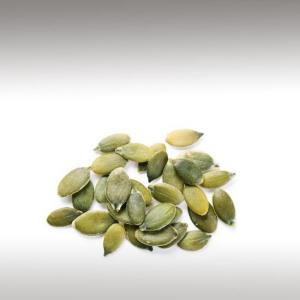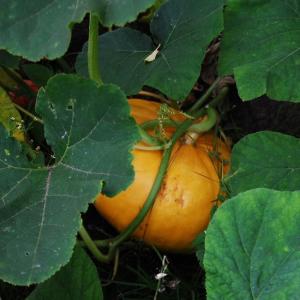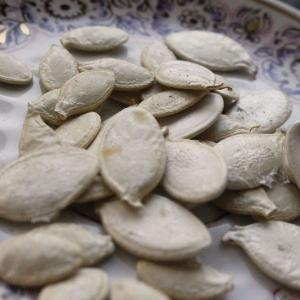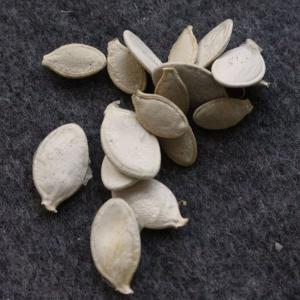
PUMPKIN SEED OIL (CUCURBITA PEPO L.) - BASE OILS

BASE / GENERAL DATA
Information submited: June 1, 2015 Modified: May 9, 2018 By: OperaDreamhouse
Cucurbita Pepo is a cultivated plant of the genus Cucurbita. It yields varieties of winter squash and Pumpkin, but the most widespread varieties belong to Cucurbita Pepo, called Summer Squash.
Cucurbita Pepo is one of the oldest, if not the oldest domesticated species. The oldest known locations are in southern Mexico in Oaxaca 8,000 - 10,000 years ago and Ocampo, Tamaulipas, Mexico about 7,000 years ago. Its ancient territory extended north into Texas and up the Greater Mississippi River Valley into Illinois and east to Florida, and possibly even to Maine. It is known to have appeared in Missouri at least 4,000 years ago. Some varieties grow in arid regions and some in moist regions.
Due to their varied genetic background, members of Cucurbita Pepo vary widely in appearance, primarily in regards to their fruits. The plants are typically 1,0 - 2,5 feet high, 2 - 3 feet wide, and have yellow flowers. Within Cucurbita Pepo, the Pumpkins, Scallops, and possibly Crooknecks are ancient and were domesticated separately. The domesticated species have larger fruits and larger yet fewer seeds. Parthenocarpy is known to occur in certain cultivars of Cucurbita pepo.
Pumpkin Seed oil has an intense nutty taste and is rich in polyunsaturated fatty acids. Browned oil has a bitter taste.
Pumpkin Seed oil is extracted from Pumpkin Seeds that have been coarsely ground and toasted at temperatures of about 60 °C. Only by this procedure, its typical flavour is developed.
Pumpkin Seed oils obtained by cold extraction are comparably tasteless. In the last years, production of Pumpkin Seed oil has much increased, since Austria’s EU membership has opened new markets.
Today the oil is an important export commodity of Austria and Slovenia. It is made by pressing roasted, hulled Pumpkin Seeds (Pepitas), from a local variety of pumpkin, the "Styrian oil Pumpkin". It has been produced and used in Styria's southern parts at least since the 18th century.
Styrian Pumpkin Seed oil is a dark greenish - black liquid, reddish on reflection and has an intense, nutty odour and flavour. It is often termed the "Styrian Black Gold" in reference to its dark colour similar to petroleum.
The viscous oil is light to very dark green to dark red in colour depending on the thickness of the observed sample. The oil appears green in thin layer and red in thick layer. Such optical phenomenon is called dichromatism.
Pumpkin oil is one of the substances with strongest dichromatism.
Chemical structure:
Pumpkin Seeds are rich sources offatty acids. The four dominant fatty acidsare palmitic, stearic, oleic, and linoleic acid.
HPLC analysis of the powerful pigments found in Pumpkin Seed oil reveal a number of carotenoids - the main components being beta catotene and lutein. In addition other carotenoids present include - violaxanthin, luteoxanthin, auroxanthin, flavoxanthin, chrysanthemaxanthin, alpha-cryptoxanthin, beta-cryptoxanthin and alpha-carotene.
Pumpkin Seeds contain 30 - 50% oil composed mainly offatty acids including palmitic, stearic, oleic and linoleic acids (these four fatty acids make up 98% of the total amount of fatty acids)
Tocopherols including beta-, gamma- and delta-tocopherol and carotenoids including lutein and beta - carotene.
Pumpkin Seed oil contains lipids:
Fatty acids, total saturated - 19,9%
Fatty acids, total monounsaturated - 32,4%
Oleic acid - 32,2%
Fatty acids, total polyunsaturated - 47,7%
Linoleic acid - 47,3%g
Linolenic acid - 0,46%
Phytosterols (in free and bound forms) approximately - 2g/100g
Cholesterol - 0g/100g.
Pumpkin Seed oil used locally in Eritrea was found to be rich in oil (approximately 35%), protein (38%), alpha - tocoferols (3mg/100 g) and carbohydrate content (approximately 37%).
The four dominant fatty acids found were: palmitic (13,3%), stearic (8,0%), oleic (29,0%) and linoleic (47,0%).
Variation in nutrient content exists between different cultivars and varieties of Pumpkin.
The flavour of Pumpkin Seeds and Pumpkin Seed oil develops in a toasting procedure, which is applied to the seeds immediately before extracting the oil. In this process, a multitude of volatile, flavourful compounds forms via the Maillard reaction. There is little scientific research in that field, but it seems that the most important flavour contributions come from pyrazines, 2,6 - dimethylpyrazine.
Cucurbita Pepo is one of the oldest, if not the oldest domesticated species. The oldest known locations are in southern Mexico in Oaxaca 8,000 - 10,000 years ago and Ocampo, Tamaulipas, Mexico about 7,000 years ago. Its ancient territory extended north into Texas and up the Greater Mississippi River Valley into Illinois and east to Florida, and possibly even to Maine. It is known to have appeared in Missouri at least 4,000 years ago. Some varieties grow in arid regions and some in moist regions.
Due to their varied genetic background, members of Cucurbita Pepo vary widely in appearance, primarily in regards to their fruits. The plants are typically 1,0 - 2,5 feet high, 2 - 3 feet wide, and have yellow flowers. Within Cucurbita Pepo, the Pumpkins, Scallops, and possibly Crooknecks are ancient and were domesticated separately. The domesticated species have larger fruits and larger yet fewer seeds. Parthenocarpy is known to occur in certain cultivars of Cucurbita pepo.
Pumpkin Seed oil has an intense nutty taste and is rich in polyunsaturated fatty acids. Browned oil has a bitter taste.
Pumpkin Seed oil is extracted from Pumpkin Seeds that have been coarsely ground and toasted at temperatures of about 60 °C. Only by this procedure, its typical flavour is developed.
Pumpkin Seed oils obtained by cold extraction are comparably tasteless. In the last years, production of Pumpkin Seed oil has much increased, since Austria’s EU membership has opened new markets.
Today the oil is an important export commodity of Austria and Slovenia. It is made by pressing roasted, hulled Pumpkin Seeds (Pepitas), from a local variety of pumpkin, the "Styrian oil Pumpkin". It has been produced and used in Styria's southern parts at least since the 18th century.
Styrian Pumpkin Seed oil is a dark greenish - black liquid, reddish on reflection and has an intense, nutty odour and flavour. It is often termed the "Styrian Black Gold" in reference to its dark colour similar to petroleum.
The viscous oil is light to very dark green to dark red in colour depending on the thickness of the observed sample. The oil appears green in thin layer and red in thick layer. Such optical phenomenon is called dichromatism.
Pumpkin oil is one of the substances with strongest dichromatism.
Chemical structure:
Pumpkin Seeds are rich sources offatty acids. The four dominant fatty acidsare palmitic, stearic, oleic, and linoleic acid.
HPLC analysis of the powerful pigments found in Pumpkin Seed oil reveal a number of carotenoids - the main components being beta catotene and lutein. In addition other carotenoids present include - violaxanthin, luteoxanthin, auroxanthin, flavoxanthin, chrysanthemaxanthin, alpha-cryptoxanthin, beta-cryptoxanthin and alpha-carotene.
Pumpkin Seeds contain 30 - 50% oil composed mainly offatty acids including palmitic, stearic, oleic and linoleic acids (these four fatty acids make up 98% of the total amount of fatty acids)
Tocopherols including beta-, gamma- and delta-tocopherol and carotenoids including lutein and beta - carotene.
Pumpkin Seed oil contains lipids:
Fatty acids, total saturated - 19,9%
Fatty acids, total monounsaturated - 32,4%
Oleic acid - 32,2%
Fatty acids, total polyunsaturated - 47,7%
Linoleic acid - 47,3%g
Linolenic acid - 0,46%
Phytosterols (in free and bound forms) approximately - 2g/100g
Cholesterol - 0g/100g.
Pumpkin Seed oil used locally in Eritrea was found to be rich in oil (approximately 35%), protein (38%), alpha - tocoferols (3mg/100 g) and carbohydrate content (approximately 37%).
The four dominant fatty acids found were: palmitic (13,3%), stearic (8,0%), oleic (29,0%) and linoleic (47,0%).
Variation in nutrient content exists between different cultivars and varieties of Pumpkin.
The flavour of Pumpkin Seeds and Pumpkin Seed oil develops in a toasting procedure, which is applied to the seeds immediately before extracting the oil. In this process, a multitude of volatile, flavourful compounds forms via the Maillard reaction. There is little scientific research in that field, but it seems that the most important flavour contributions come from pyrazines, 2,6 - dimethylpyrazine.

SPIRITUAL PRACTISES DATA

MEDICINE / HEALTH DATA

BEAUTY / COSMETICS DATA

FOOD / COOKING DATA
COMMENTS
No comments.





